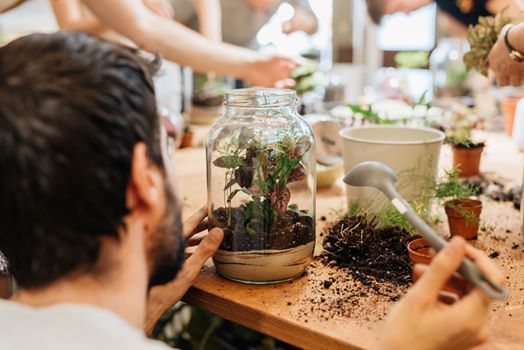
Brings the outdoors in by learning which plants and how to care for it after you can take it home. A Terrarium Workshop is a little nursery, an ideal method to bring nature indoors. In our fun and involved workshops, you will figure out how to pick the most reasonable plants just as how to really focus on them. At that point the time has come to get filthy and make your own, adding additional interest with characteristic accomplices to make it unique. One of the best things about terrariums is that they are so natural to deal with. When the difficult work of assembling every one of your plants is done, your terrarium will gradually begin to get self reasonable in the fixed scaled-down eco-framework that you’ve assembled! Here’s a couple of supportive tips on watering, light levels and general upkeep to help you care for your new terrarium and to make the plants inside it flourish.
A solid recently fixed terrarium

Tropical plants consistently work best within a terrarium, since they love the stickiness the terrarium will create. Heaps of the well-known plants generally utilized in terrariums Whenever you’ve completed your terrarium and watered it in, that first water will start to push through the plants over and again, making a smaller than normal climate arrangement of its own. This is the reason charcoal is so significant, as it helps clean the water and stops it turning out to be stagnant. After a short time, you’ll notice some obvious stickiness and dampness within the glass. It shows you that your terrarium has a solid measure of water going through its framework. It’s valuable to watch out for the stickiness as when the glass clears, you need to see about 33% of your container with water beads on it during the day. On the off chance that it’s not exactly that it very well may be a sign, your terrarium may require a little water added. At the point when this occurs, check the dirt with your finger on the off chance that you can, if there’s still some dampness in the dirt, leave it for a few days. If you can’t accommodate your hand into your terrarium, investigate a portion of the fertilizer and perceive how hydrated it looks terrariums.
Ensure:
You shouldn’t have to water your terrarium a lot by any stretch of the imagination. When set up and solid you frequently won’t have to water a terrarium for quite a long time at a time, and if it’s large enough you will not have to water it by any means. When watering, it’s extraordinary to utilize water or deionized water yet in case you’re utilizing faucet water, empty some into a bowl and forget about it for a day. This aids any chlorine and different synthetics dissipate off and gives you cleaner, more plant benevolent water. A few plants like Calatheas or Alocasias truly battle with what’s in our faucet water, and you can here and there see leaves creating evaporated earthy coloured spots or a white buildup created on the outside of the fertilizer. Simply be certain not to leave the terrarium open for a really long time once you’re watering it to make sure you don’t upset it’s current circumstance too much. Light levels are additionally significant with terrariums.

